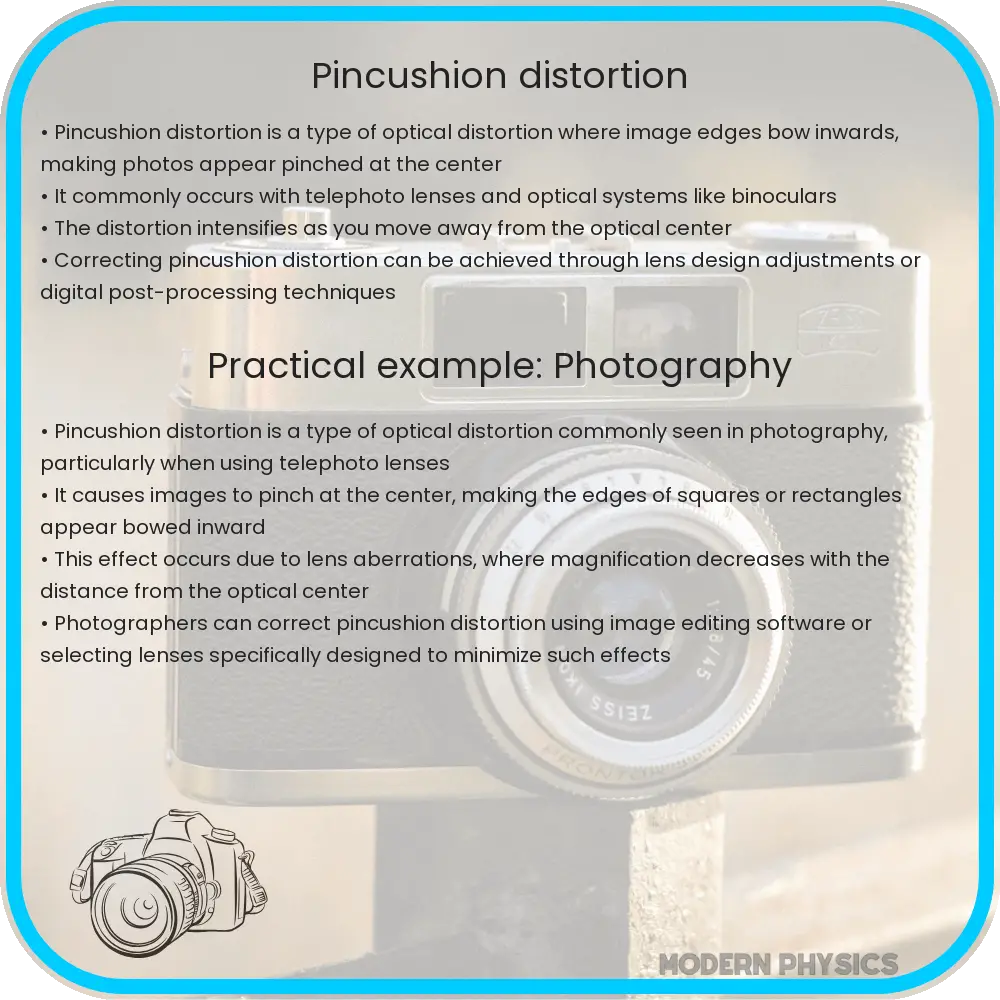Explore pincushion distortion: causes, corrections, and optics basics. Learn about lens aberrations, correction techniques, and future technologies.

Pincushion Distortion: Understanding the Phenomenon
Pincushion distortion is a common optical effect encountered in photography, microscopy, and other fields involving lens systems. This type of distortion causes the image to appear pinched at its center, resembling the shape of a pincushion. It is particularly noticeable in images with straight lines, as they appear to bend inwards towards the center of the image.
Causes of Pincushion Distortion
The primary cause of pincushion distortion is the optical design of the lens. It occurs when the magnification of an image increases with the distance from the optical axis. In simpler terms, light rays passing through the outer parts of a lens are bent more than those passing through the center, causing the image edges to appear closer together than they are.
- Barrel Distortion: The counterpart to pincushion distortion is barrel distortion, where image magnification decreases with distance from the optical axis, leading to an image that bulges outward.
- Zoom Lenses: Pincushion distortion is more common in zoom lenses, especially at the telephoto end of the zoom range.
- Lens Quality: Higher quality lenses typically have better distortion correction, but even the best lenses may exhibit some level of pincushion distortion.
Correcting Pincushion Distortion
There are several ways to correct pincushion distortion, both in-camera and during post-processing:
- In-Camera Correction: Many modern digital cameras have built-in correction features that automatically adjust for lens distortion.
- Software Correction: Post-processing software like Adobe Photoshop or Lightroom can be used to manually adjust the distortion.
- Lens Design: Some lenses are specifically designed to minimize distortion through complex lens element arrangements and special coatings.
Optics Basics: Lens Distortion
Understanding pincushion distortion requires a basic knowledge of optics and how lenses work. Lenses refract light rays to focus them onto an image sensor or film plane. The shape and arrangement of the lens elements determine how the light is bent and, consequently, the type of distortion that occurs.
In conclusion, pincushion distortion is an inherent characteristic of many optical systems. While it can be a nuisance, especially in architectural and landscape photography where straight lines are crucial, it is correctable through various methods. A comprehensive understanding of this phenomenon not only aids in managing it but also enriches one’s knowledge of optical science.
Advanced Techniques in Correcting Pincushion Distortion
For professionals seeking precision, more advanced techniques are available to correct pincushion distortion:
- Optical Correction Lenses: These auxiliary lenses, when attached to the primary lens, help in correcting distortion without digital intervention.
- Custom Calibration: Some photographers and videographers use lens calibration tools to measure distortion and create custom correction profiles.
Impact of Pincushion Distortion on Various Fields
Pincushion distortion affects various fields differently:
- Photography: In photography, especially in architectural and landscape genres, distortion can significantly alter the perceived geometry of structures and horizons.
- Astronomy: For telescopic lenses, distortion can affect the accuracy of celestial observations.
- Microscopy: In microscopy, distortion can lead to misinterpretation of sample structures, impacting scientific research.
Future of Lens Technology and Distortion
The future of lens technology shows promising developments towards minimizing lens distortions. Advancements in computational photography and lens manufacturing technologies aim to deliver lenses with minimal aberrations and distortions.
- Computational Photography: This emerging field combines optical design with software algorithms to correct distortion in real-time.
- Nano-fabrication Techniques: New techniques in lens manufacturing allow for more precise control over lens shapes, leading to better distortion control.
Conclusion
Pincushion distortion, a common optical aberration, presents challenges and learning opportunities for photographers, videographers, and optical professionals. Understanding its causes and correction methods is essential for producing accurate visual representations. The continuous advancements in lens technology and digital image processing are paving the way for more effective management of this and other types of lens distortion. As technology evolves, the balance between optical design and digital correction is likely to become more sophisticated, allowing for higher quality imagery with minimal manual intervention. Embracing these advancements, professionals and enthusiasts alike can look forward to a future where optical imperfections are less of a hurdle and more of a manageable aspect of the photographic and videographic arts.
